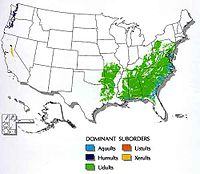Ultisol
| Ultisols | |
|---|---|
| Red Clay Soil | |
 an Ultisol profile | |
| Key process | weathering |
| Climate | tropical, humid subtropical, oceanic |
Ultisols, commonly known as red clay soils, are one of twelve soil orders in the United States Department of Agriculture soil taxonomy. They are defined as mineral soils which contain no calcareous material anywhere within the soil, have less than 10% weatherable minerals in the extreme top layer of soil, and have less than 35% base saturation throughout the soil. Ultisols occur in humid temperate or tropical regions. While the term is usually applied to the red clay soils of the Southern United States, ultisols are also found in regions of Africa, Asia, and South America. In the World Reference Base for Soil Resources system, most ultisols are known as acrisols. Others with higher-activity clays are classed as alisols or nitisols.
The word "ultisol" is derived from "ultimate", because ultisols were seen as the ultimate product of continuous weathering of minerals in a humid, temperate climate without new soil formation via glaciation.
Ultisols vary in color from purplish-red, to a bright reddish-orange, to pale yellowish-orange and even some subdued yellowish-brown tones. They are typically quite acidic, often having a pH of less than 5. The red and yellow colors result from the accumulation of iron oxide (rust), which is highly insoluble in water. Major nutrients, such as calcium and potassium, are typically deficient in ultisols, which means they generally cannot be used for sedentary agriculture without the aid of lime and other fertilizers, such as superphosphate. They can be easily exhausted, and require more careful management than alfisols or mollisols. However, they can be cultivated over a relatively wide range of moisture conditions.
Ultisols can have a variety of clay minerals, but in many cases the dominant mineral is kaolinite. This clay has good bearing capacity and no shrink–swell property. Consequently, well-drained kaolinitic ultisols such as the Cecil series are suitable for urban development.
Ultisols are the dominant soils in the Southern United States (where the Cecil series is most famous), southeastern China, Southeast Asia, and some other subtropical and tropical areas. Their northern limit (except fossil soils) is very sharply defined in North America by the limits of maximum glaciation during the Pleistocene, because ultisols typically take hundreds of thousands of years to form—far longer than the length of an interglacial period today.
The oldest fossil ultisols are known from the Carboniferous period when forests first developed. Though known from far north of their present range as recently as the Miocene, ultisols are surprisingly rare as fossils overall, since they would have been expected to be very common in the warm Mesozoic and Tertiary paleoclimates.
-
Red clay soil is common throughout the Southern United States, especially around the Piedmont. This photo was taken in North Carolina.
-
Red clay soil is common throughout the Southern United States, especially around the Piedmont. This photo was taken in North Carolina.
-
Map showing distribution and types of ultisols throughout the United States; there is no ultisol on the Ohio River flood plains, as the river has historically deposited other soil types there during its regular natural flooding.
-
Map of the United States showing what percentage of the soil in a given area is classified as an ultisol-type soil. The great majority of the land area classified in the highest category (75%-or-greater ultisol) lies in the South and overlays with the Piedmont Plateau, which runs as a diagonal line through the South from southeast (in Alabama) to northwest (up through Virginia, and even into parts of Maryland).
Suborders
- Aquults: Ultisols with a water table at or near the surface for much of the year
- Humults: well-drained ultisols that have high organic matter content
- Udults: Ultisols of humid climates
- Ustults: Ultisols of semiarid and subhumid climates
- Xerults: temperate ultisols with very dry summers and moist winters
See also
References
- "Ultisols". United States Department of Agriculture. Retrieved 2008-01-04.
- "Ultisols". University of Florida. April 2007. Archived from the original on September 21, 2004. Retrieved 2006-05-14.
{{cite web}}: Cite has empty unknown parameter:|1=(help); Unknown parameter|deadurl=ignored (|url-status=suggested) (help) - "Ultisols". University of Idaho. Retrieved 2006-05-14.




